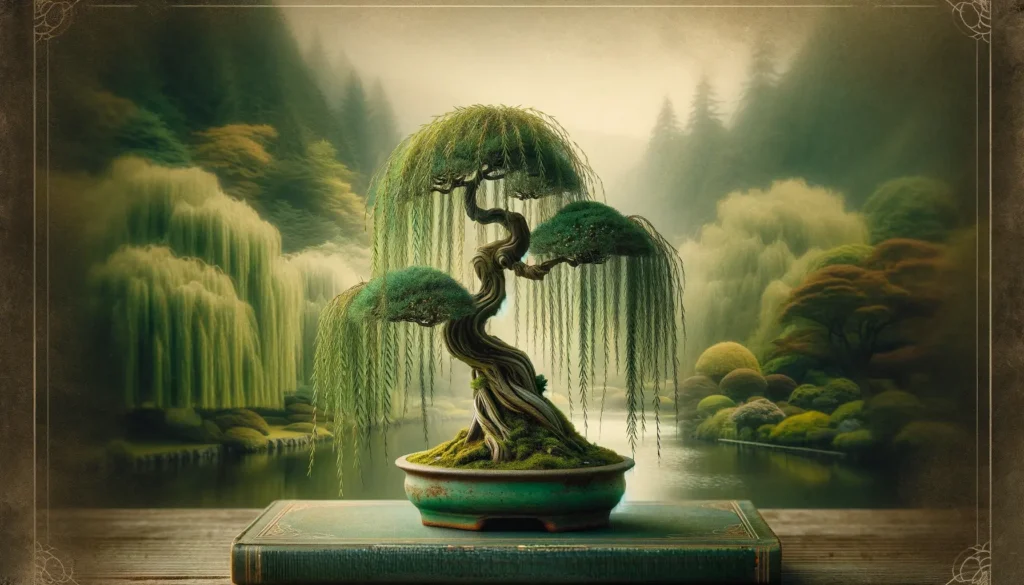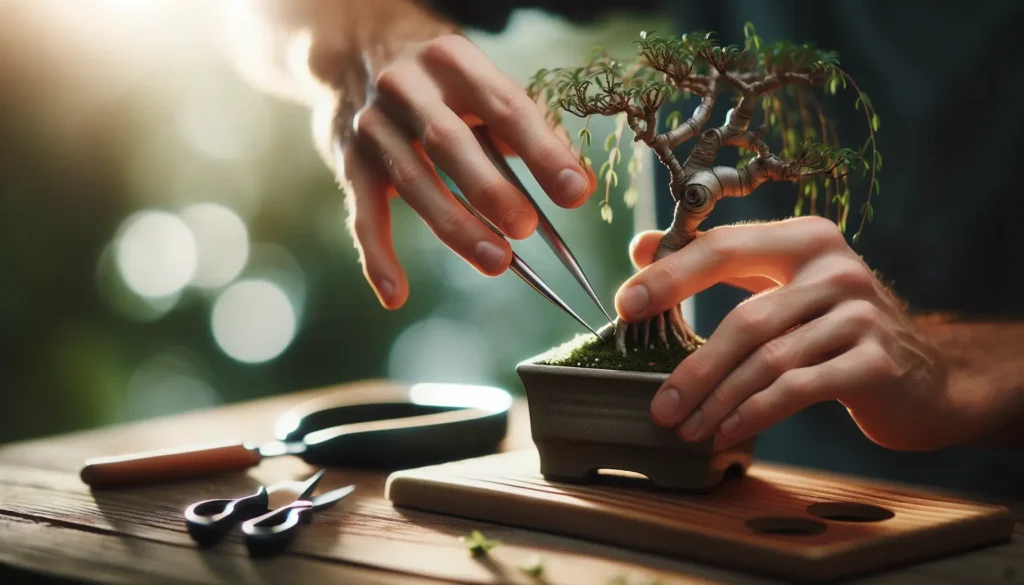The Alluring Art of Weeping Willow Bonsai: A Comprehensive Guide to Cultivation
Introduction
There’s a certain magic in the weeping willow bonsai that transcends the boundaries of traditional gardening. A living sculpture that weaves history, art, and horticulture into its cascading branches. The weeping willow bonsai, or Salix babylonica, symbolizes both sorrow and hope throughout various cultures. Its downward sweeping, delicate branches offer a visual metaphor for tears, while the resilience of the tree symbolizes the ability to thrive and adapt.
The art of bonsai, with its roots deeply planted in ancient traditions, turns the cultivation of trees into a form of self-expression. Among these, the weeping willow bonsai stands out for its elegant cascade and its peaceful ambiance. This guide will explore how to cultivate your weeping willow bonsai, transforming a simple willow into a bonsai masterpiece.
Cultivating Your Weeping Willow Bonsai

Choosing the Right Willow Species
When embarking on the journey of bonsai cultivation, selecting the right species is crucial. The Salix babylonica, with its slender and flexible branches, is particularly suited for creating a bonsai art piece.
- Salix babylonica: Known for its graceful drooping habit, it is the quintessential choice for a weeping willow bonsai.
- Salix matsudana ‘Tortuosa’: Also known as the curly willow, offers an interesting twist with its contorted branches.
- Salix caprea (Pussy willow): While not a traditional weeping willow, it can be styled to give the impression of a weeping tree, especially when in bloom.
When choosing your willow, consider the visual impact of its leaves, the color of its bark, and the overall growth pattern. Each cultivar presents its own characteristics that will influence the bonsai’s appearance and cultivation requirements.
Acquiring Your Willow Bonsai
A weeping willow bonsai can be acquired through various means:
- Purchasing from Specialized Nurseries: This is the quickest way to start, as you’ll get a pre-cultivated bonsai that has already been shaped to some extent.
- Propagation from Cuttings: A cost-effective and rewarding method allowing you to shape the tree from its early stages.
- Collecting from Nature: While this can be the most challenging, it allows you to work with a tree that has already developed character.
When selecting a tree, ensure it has a strong root structure, a balanced branch arrangement, and signs of vigorous growth. These attributes are foundational to a healthy weeping willow bonsai.
Establishing the Ideal Growing Environment
The right environment is paramount for your weeping willow bonsai to flourish:
- Sunlight: Full sun to partial shade is ideal for promoting healthy growth.
- Soil: A well-draining soil mix will prevent root rot and support the tree’s growth.
- Watering: Keep the soil moist but not waterlogged, mimicking the natural conditions of a willow’s habitat.
- Temperature: Protect your bonsai from extreme temperatures; while willows are hardy, bonsai trees are more susceptible to environmental stress.
Pruning and Shaping Your Bonsai

Pruning is not just about maintaining size; it’s about defining the essence of your bonsai. For the weeping willow bonsai, pruning helps emphasize its natural elegance and ensure the tree’s health.
- Timing: The best time to prune your weeping willow bonsai is during the late winter or early spring before the sap starts to flow.
- Tools: Use sharp, clean tools specifically designed for bonsai to make precise cuts.
- Techniques: Identify the main structure of your tree and trim back the new growth to shape. Regular pruning will encourage the development of smaller, more plentiful leaves.
Bonsai Styles:
- Cascade: This style mimics a tree growing over the side of a cliff.
- Informal Upright: A slightly curved trunk, this style follows a more natural tree growth pattern.
- Semi-Cascade: Similar to cascade but the trunk does not go below the bottom of the pot.
Choose a style that resonates with you, and let it guide the pruning and wiring of your weeping willow bonsai.
Nurturing and Maintaining Your Bonsai
Feeding Your Weeping Willow Bonsai:
- A balanced diet is vital for your weeping willow bonsai. During the growing season, apply a balanced fertilizer every four weeks. In the autumn, switch to a low-nitrogen feed to help harden off the growth. Here’s a fertilization schedule to keep your bonsai in top condition:
- Spring to Summer: High-nitrogen fertilizer to support vigorous growth.
- Late Summer: Balanced fertilizer to prepare for the next season.
- Autumn: Low-nitrogen fertilizer to strengthen the tree for winter.
Watering Practices:
- Willows love water but despise waterlogged roots. It’s a delicate balance. The watering frequency depends on several factors, such as temperature, pot size, and soil mixture. As a rule of thumb, water when the topsoil feels slightly dry. Here’s how to get it right:
- Check Moisture Levels: Use a moisture meter or your finger to check the soil’s moisture.
- Watering Technique: Water thoroughly until it runs out of the drainage holes, then let the soil drain.
- Misting: Willows appreciate a humid environment. Mist the leaves regularly, especially in dry conditions.
Pest and Disease Management:
- Regular monitoring is key to preventing infestations and disease. Here’s what to look for and how to manage common issues:
- Aphids and Spider Mites: These pests can be controlled with a gentle insecticidal soap or neem oil.
- Powdery Mildew and Root Rot: Fungal diseases like these thrive in moisture. Ensure good air circulation and soil drainage to prevent them.
Repotting Essentials:
- Repotting is crucial for maintaining a healthy root system and should be done with care. Follow these steps:
- When to Repot: Typically, young willow bonsai need repotting every two years, while older ones can be repotted every three to five years.
- The Process: Gently remove the tree from its pot, prune away up to one-third of the root mass, and repot with fresh bonsai soil.
- Aftercare: Clean your newly potted bonsai in a shaded area and thoroughly water. Avoid fertilizing for about a month to allow the roots to recover.
Seasonal Care:
- Your weeping willow bonsai requires different care as the seasons change:
- Spring: This is the time for pruning and repotting. It’s also when you should start your fertilization regimen.
- Summer: Vigilant watering is crucial in the heat. Shield your bonsai from the extreme sun.
- Autumn: Prepare your bonsai for dormancy. Reduce watering and stop fertilizing.
- Winter: If you live in a cold climate, protect your bonsai from frost. This may involve moving it to a cold but frost-free area.
Long-term Commitment:
- Bonsai is a long-term commitment. A well-cared-for weeping willow bonsai can live for decades, with some specimens surviving for over a century. Your relationship with your bonsai is a living, evolving journey that can bring a profound sense of fulfillment and peace.
By dedicating time to understanding the needs of your weeping willow bonsai and responding with the right care practices, you’ll nurture a tree and your connection with the natural world.
Conclusion
In this guide, we’ve traversed the path of cultivating a weeping willow bonsai, from selecting the right species to establishing the ideal environment and from precise pruning to diligent care. Remember, bonsai cultivation is a journey, not a destination. It’s a continuous process of learning, experiencing, and connecting with nature.
Embrace the challenges and rewards as you shape not just a tree but a living work of art. For those keen to delve deeper into the world of bonsai, numerous resources are available online. Websites like Bonsai Empire and Bonsai Network offer extensive articles and videos to expand your knowledge and skills.
Take the next step in your bonsai journey, and may the graceful branches of your weeping willow bonsai inspire tranquility and joy in your gardening endeavors.
Further Reading and Resources
Delve deeper into the art and science of bonsai cultivation with these handpicked resources:
- Bonsai Empire: A treasure trove of tutorials, care guides, and stories from the Bonsai world.
- Bonsai Network: A YouTube channel with many videos on various bonsai care aspects.
- International Bonsai Magazine: Offering insights and techniques from bonsai masters around the globe.
- American Bonsai Society: Workshops, conventions, and publications for bonsai enthusiasts in America.
- Bonsai Clubs International: Connect with other practitioners and engage in forums and discussions.
- The Bonsai Channel: Visual content rich with bonsai training, shaping, and maintenance tips.
- Bonsai4Me: Detailed horticultural articles and species-specific bonsai advice.
- Bonsai Outlet: A store for tools, pots, trees, and care sheets for various bonsai species.
These links lead to external sites packed with information that can help both novice and experienced bonsai enthusiasts refine their skills and expand their knowledge base.
Frequently Asked Questions About Weeping Willow Bonsai
How can I properly care for a bonsai weeping willow tree? Consistent moisture is key for weeping willows. Water regularly to keep the soil moist, provide full sun or partial shade, maintain mild to warm temperatures (60-75°F or 15-24°C), and higher humidity. Regular pruning is necessary for shape and size maintenance and use a balanced fertilizer during the growing season.
What are the specific watering requirements for a weeping willow bonsai? Weeping willow bonsai should be watered when the topsoil feels dry. They require consistent moisture but be careful not to overwater as this can lead to root rot.
Are there any particular pruning techniques for a weeping willow bonsai? Prune during late winter or early spring before the sap starts to flow. Focus on maintaining the tree’s cascading shape and controlling its size. Wiring can be used to direct the growth of branches.
How often should I repot my weeping willow bonsai? Generally, young weeping willow bonsai should be repotted every two years, while older ones can be repotted every three to five years, preferably during the spring.
Can I keep my weeping willow bonsai indoors? Weeping willows thrive outdoors but can be kept indoors if they receive sufficient sunlight and are protected from extreme temperature changes.
What type of fertilizer is best for weeping willow bonsai? A balanced fertilizer is suitable for weeping willows. Use it during the growing season, following the instructions to avoid over-fertilization.
How do I protect my weeping willow bonsai from pests and diseases? Inspect your bonsai regularly for signs of pests or disease. Treat any infestations or infections early with appropriate pesticides or organic methods.
What is the best soil for a weeping willow bonsai? A well-draining bonsai soil mix is best, which will retain moisture without becoming waterlogged.
How do I style a weeping willow bonsai? The styling depends on your preference, but popular styles for weeping willows include cascade, semi-cascade, and informal upright.
Can a weeping willow bonsai be grown from cuttings? Yes, weeping willow bonsai can be propagated from cuttings, which is a cost-effective method to start your bonsai journey.

